Owais Mughal
 Clicking on photos in this article will take you to their source web site as well as larger image sizes.
Clicking on photos in this article will take you to their source web site as well as larger image sizes.
Taking a trip through famous landmarks of Pakistan Railway network has remained a favourite topic at ATP. In the past few months we have travelled through Bolan Pass, Khyber Pass and Chappar Rift. Today we’ll visit yet another marvel of civil and mechanical engineering present on Pakistan’s Railway Network. It is called the Khojak tunnel. Built 115 years ago (September 1891), it was then the fourth longest tunnel in the world and to date it is the longest tunnel in Pakistan.
The photo to the right shows the fortified entrance to Khojak Tunnel. This photo was first published in 1910 by Mullick Brothers of Quetta.
Why was Khojak Tunnel built?
The construction of Sibi-Quetta-Chaman railway line was planned in 1857-58 with the ultimate aim of taking it to Kandahar, and forestalling the threat of Russian offensive in India. At that time there was a recurrent fear of Russian invasion into India through the Bolan pass. Some graves of Russian noblemen from 1850s are found in Sibi-Khost area of Baluchistan which suggests that Russians were already active in this area.
Following photo is also circa 1910 and shows a ceremony going on at the tunnel entrance. The locomotive shown in the photo appears to be an Indian Class L 4-6-0.
 British captured Quetta and its adjoining area in 1876 and formed the Kandahar State Railways with an aim to connect Sukkur (Sindh) with Kandahar (Afghanistan). Work began in 1879. However, by 1888, the idea of building the railway line upto Kandahar was dropped. The project was renamed Chaman Extension Railway. The railway line would now go up to Chaman only. Chaman is the last Pakistani station on Pak-Afghan border.
British captured Quetta and its adjoining area in 1876 and formed the Kandahar State Railways with an aim to connect Sukkur (Sindh) with Kandahar (Afghanistan). Work began in 1879. However, by 1888, the idea of building the railway line upto Kandahar was dropped. The project was renamed Chaman Extension Railway. The railway line would now go up to Chaman only. Chaman is the last Pakistani station on Pak-Afghan border.
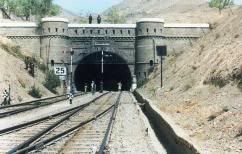 To reach Chaman, railway line had to pass through Khojak pass which was an unsurmountable obstacle at that time. Hence it was decided to tunnel this pass, and the project was named as Khojak Tunnel.
To reach Chaman, railway line had to pass through Khojak pass which was an unsurmountable obstacle at that time. Hence it was decided to tunnel this pass, and the project was named as Khojak Tunnel.
The photo to the right shows the tunnel entrance from Quetta side.
Location:
Built in the historic Khojak pass, the tunnel is located some 113 km from Quetta on the Quetta-Chaman Railway line. 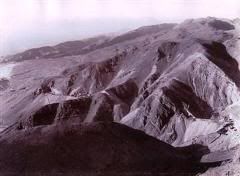 Khojak pass itself is located across the Khwaja-Amran offshoot of the Toba-Kakar mountains.
Khojak pass itself is located across the Khwaja-Amran offshoot of the Toba-Kakar mountains.
The Khwaja-Amran mountain is shown in the photo to the left. The tunnel is built under these mountain.
The tunnel is located between the towns of Sanzala and Shelabagh. The pass reaches its crest at Shelabagh railway station at an altitude of 5394 feet above seal level. Considering Quetta as 0 km and skipping smaller towns enroute following table gives an idea of Khojak’s location and altitudes.
Quetta 0 km at 5599 ft
Bostan 33 km at 5154 ft
Gulistan 82 km at 4838 ft
Kila Abdullah 96 km at 5186 ft
Shelabagh 112 km at 5394 ft
Khojak Tunnel
Sanzala 123 km
Chaman 142 km at 4034 ft
The colored photo to the above right is coutesy of Mr. Nicholas Lera and shows Sanzala Station which is at the west entrance of Khojak tunnel. Photo is circa February 1997.
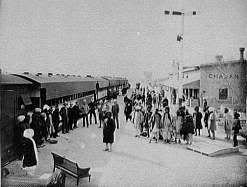 The landscape of this whole area is very inhospitable. It is mostly without any vegetation. The name of towns here however, give a false impression of this area being very green. But the truth is there is no blooming flower in Gulistan (the land of flowers), there is no fort in Kila Abdullah (Fort Abdullah), no garden in Shelabagh (Garden of Shela) and no fruit garden in Chaman (fruit garden). There used to be however, a huge traffic of fruit from Afghanistan into India. Before 1947 there was a daily fruit train from Chaman equipped with ice-packed refrigerated vans which took fruit to places as far away as Calcutta and Chennai (the then Madras).
The landscape of this whole area is very inhospitable. It is mostly without any vegetation. The name of towns here however, give a false impression of this area being very green. But the truth is there is no blooming flower in Gulistan (the land of flowers), there is no fort in Kila Abdullah (Fort Abdullah), no garden in Shelabagh (Garden of Shela) and no fruit garden in Chaman (fruit garden). There used to be however, a huge traffic of fruit from Afghanistan into India. Before 1947 there was a daily fruit train from Chaman equipped with ice-packed refrigerated vans which took fruit to places as far away as Calcutta and Chennai (the then Madras).
The photo to the above left shows Chaman station in 1895. Photographer is William Henry Jackson.
The Construction Phase (1889-1891):
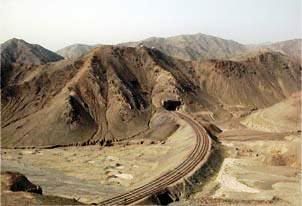 The total Length of Khojak tunnel is 3.912 km (2.415 mi). Something this gigantic was never constructed in the sub-continent before.
The total Length of Khojak tunnel is 3.912 km (2.415 mi). Something this gigantic was never constructed in the sub-continent before.
The photo to the right shows Chaman side entrance of Khojak tunnel.
At the time of construction of this tunnel, there was no skilled lobour available for the job in India. Equipment and Iron works had to be ordered from England. An Army of laborers was recruited from all parts of India as well as other countries. The workers for Khojak Tunnel came from Herat, Seistan, Kandahar, Ghazni, Kabul, Jalalabad, Swat, Bannu, Kafiristan, Kashmir, Tibet, Punjab, Mekran, Arabs from the Persian Gulf and Zanzibar. There were a large number of Hazara people as well as Sikh carpenters and masons and brick burners from Bengal. 65 Welsh miners were especially recruited for the Khojak Tunnel project, who had experience in building the Severn Tunnel through the treacherous water-bearing strata of England.
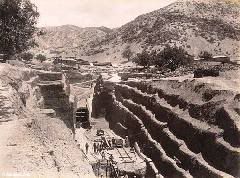 The work on Khojak Tunnel began on April 14, 1888 and the first steam engine rolled through the completed tunnel on September 5, 1891.
The work on Khojak Tunnel began on April 14, 1888 and the first steam engine rolled through the completed tunnel on September 5, 1891.
The photo to the left is taken by Fred Bremmer in 1889 and it shows the drilling process being carried on Khojak Tunnel from Shelabagh side.
As thousands of workers were working on Khojak tunnel there was not enough drinking water available in the area. Therefore up to 80 tonnes of water was trasported daily to the construction site by rail. The Khojak Pass is also notorious for cold winds that blow here during winters and many people died of pneumonia during the construction phase of the tunnel. In the winter of 1890-91 a breakout of typhoid killed 800 workers in 4 months.
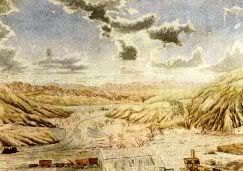 Image to the right is a hand painted view of under construction Khojak Tunnel.
Image to the right is a hand painted view of under construction Khojak Tunnel.
Nature and disease were not the only callenges faced at Khojak Tunnel. Work on tunnel was started from both ends but due to some surveying error the two tunnels did not meet in the center and the engineer in charge attempted suicide. In second attempt the error was corrected and both tunnels met in the center, however, it created a very distinguished hump (crest) in the center of the tunnel. An automatic bell was installed at this hump. As soon as the train crossed this hump, this bell used to ring and train engineer would know that he had reached the center of the tunnel. This automatic bell is still working. 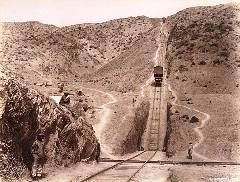
During construction phase, a temporary trolley incline was used to transfer the construction men and material up and over the pass. The trolley was pulled up be a rope.
See the photo to the left which is also taken by Mr. Fred Bremmer in 1889. In the enlarged image you can note how the trolley line splits into two near the top so that ascending and descending trolleys can cross eachother.
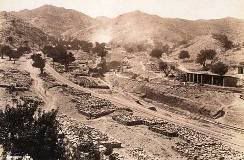 Workers at Khojak Tunnel site used to be overly fatigued as 19 million (19,724,426 to be exact) bricks to line the Khojak tunnel had to be burned on the site kiln. The there were 5Â more tunnels to be built in the area besides the Khojak Tunnel. 6549 candles were used inside the tunnel during the time of bore to keep it lit.
Workers at Khojak Tunnel site used to be overly fatigued as 19 million (19,724,426 to be exact) bricks to line the Khojak tunnel had to be burned on the site kiln. The there were 5Â more tunnels to be built in the area besides the Khojak Tunnel. 6549 candles were used inside the tunnel during the time of bore to keep it lit.
The photo to the right is of the under construction entrance of the tunnel from the Shelabagh side. Photographer is Mr. Fred Bremmer. Note how brick deposits to be used for tunnel lining are laying on the ground.
The railway line stopped short of Durand Line border at Chaman where a huge dump of permanent way material was created in the event that the extension to Kandahar proved necessary. This storage of material was later removed and sent to other parts of India after it was realized that railway line upto Kandahar was not needed anytime in near future.
Grades inside the Tunnel
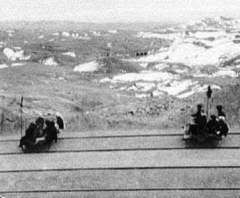 The tunnel is mostly straight but there are vertical grades. Starting from Shelabagh the line first rises at 1 in 1000 grade, then it levels off for a while before gowing downward at 1 in 500, 1 in 88 and 1 in 40 grades.
The tunnel is mostly straight but there are vertical grades. Starting from Shelabagh the line first rises at 1 in 1000 grade, then it levels off for a while before gowing downward at 1 in 500, 1 in 88 and 1 in 40 grades.
The photo to the left shows members of World Transportation commission crossing Khojak Pass in two hand cars in the year 1895. Photo is taken by William Henry Jackson.
The Legend behind Shelabagh
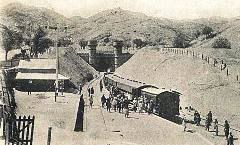 On the eastern entrance of the tunnel there is a very small settlement called Shelabagh.
On the eastern entrance of the tunnel there is a very small settlement called Shelabagh.
The photo to the right shows the tunnel entrance after it was completed in 1892 as well as the Shelabagh station.
An interesting account, which has been published by Pakistan Railways is worth mentioning:
“A popular legend has it that Shela Bagh was named after Shela, an Indian dancer who used to divert the attention of tired workers. Like many other legends, this one about the origin of the name may be purely fictional but the tunnel itself, which stands as a living monument of the Britishers’ engineering skill, industry and commitment, is a fact undoubted enchanting and inspiring“.
State Bank prints Khojak Tunnel Image on Rs 5 Note.
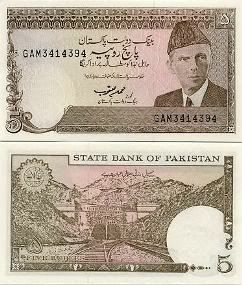 In 1976, State Bank of Pakistan paid their part of homage to this great engineering feat by printing the image of Khojak Tunnel entrance on the Rupee 5 note. This note remained in circulation until 2005.
In 1976, State Bank of Pakistan paid their part of homage to this great engineering feat by printing the image of Khojak Tunnel entrance on the Rupee 5 note. This note remained in circulation until 2005.
Photo to the left is a sample of Rs 5 note of Pakistan showing Khojak Tunnel printed on it.
Lighting inside the Tunnel
Since 1891, huge convex mirrors mounted on a trolley are used to light the Khojak tunnel. These mirrors are placed at the tunnel entrance and sunlight is reflected in to the tunnel while maintenance work is carried out. These mirror trollies are housed at a shed near the tunnel. It is interesting to note that 115 years have passed but same old method is being used to light up the tunnel even today. A friend who recently travelled through Khojak Tunnel has following to say about the mirrors that are used for lighting.
“At Shelabagh, we had a unique and very interesting experience to go inside the tunnel and ride a manually driven inspection trolley. In the honour of the distinguished guests, which we were, the seat of trolley was made more comfortable by putting a blanket on the wooden bench. Two men started pushing the trolley while running on the rail track. When we got upto a good speed, both men stopped pushing the cart and jumped on. Here we also experienced the use of mirrors to reflect sunlight into the tunnel. The mirrors lit the whole tunnel and it was a great idea to produce light without any fuel or machine. This light was bright enough that I had to request them to stop reflecting it so that I could take some photogrpahs, in which I wanted to have dark background, to show the inside of the tunnel. “
King Amanullah’s journey through Khojak Tunnel
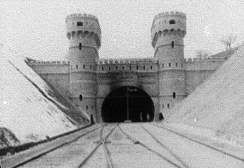 One of the interesting incident with khojak tunnel is recorded as the Royal visit of King Amanullah. In December of 1927 King Amanullah of Afghanistan and his queen started on a 7 month official visit to India, Egypt and Europe. The purpose of this visit was to learn ways and means on how to modernize Afghanistan. The British viceroy in India sent a special train called the Vice-Regal to Chaman to bring the King to India (Quetta, karachi and Mumbai to be exact) from where he was going to embark on his journey to Egypt and Europe. The Vice-Regal train to Chaman consisted of 4 steam locomotives and 12 coaches. The locomotives were of HG/S 2-8-0 type. Two locomotives were used at the front and two at the back of the train. When the train went inside the Khojak tunnel, either the King himslef or some one from his party got alarmed at the long smoky tunnel and pulled the communications cord. It caused a coupling to break and the train came to a halt inside the tunnel. It took 20 minutes to restart the train and get it going again.
One of the interesting incident with khojak tunnel is recorded as the Royal visit of King Amanullah. In December of 1927 King Amanullah of Afghanistan and his queen started on a 7 month official visit to India, Egypt and Europe. The purpose of this visit was to learn ways and means on how to modernize Afghanistan. The British viceroy in India sent a special train called the Vice-Regal to Chaman to bring the King to India (Quetta, karachi and Mumbai to be exact) from where he was going to embark on his journey to Egypt and Europe. The Vice-Regal train to Chaman consisted of 4 steam locomotives and 12 coaches. The locomotives were of HG/S 2-8-0 type. Two locomotives were used at the front and two at the back of the train. When the train went inside the Khojak tunnel, either the King himslef or some one from his party got alarmed at the long smoky tunnel and pulled the communications cord. It caused a coupling to break and the train came to a halt inside the tunnel. It took 20 minutes to restart the train and get it going again.
The photo to above left shows the western end of Khojak Tunnel in 1895. Photographer is William Henry Jackson.
Future Plans
In November 2005, the Government of Balochistan commissioned Pakistan Railways for undertaking feasibility for extending the purview of usage of the Khojak tunnel. The study would look into the prospects of whether the current rail tunnel can be converted into a rail cum road tunnel, or can there be an alternate provision for a new road tunnel. The other proposal is to widen the upper limits of the tunnel to use it as rail tunnel able to have extra headroom for the provision of train movement with roll on, roll off easiness for tractors and counter mounted trucks.
Khojak Tunnel is also expected to lose its title of longest tunnel in Pakistan to Lowari tunnel which will be 8.6 km (5.3 mile) long and is expected to open in 2008.
About Fred Bremmer‘s Photos of Khojak Tunnel at harappa.com
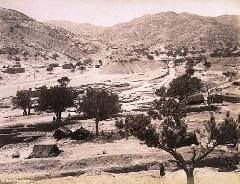 As you may have noticed already, most of the photos in this article are photographed by Fred Bremmer. Here is a brief description of how Fred Bremmer got involved with Khojak Tunnel project. In 1889 Baluchistan had a British Governer. His name was Robert Sandeman. The present city of Zhob had its earlier name Fort Sandeman named after him. Sandeman invited British viceroy Lord Lansdowne to meet Khan of Kalat in 1889. Kalat was a semi-autonomous area of Baluchistan in those days and the ruler used the title ‘Khan’. A British photographer Fred Bremmer who was there to photograph the occasion also took some photos of the under construuction Khojak Tunnel.
As you may have noticed already, most of the photos in this article are photographed by Fred Bremmer. Here is a brief description of how Fred Bremmer got involved with Khojak Tunnel project. In 1889 Baluchistan had a British Governer. His name was Robert Sandeman. The present city of Zhob had its earlier name Fort Sandeman named after him. Sandeman invited British viceroy Lord Lansdowne to meet Khan of Kalat in 1889. Kalat was a semi-autonomous area of Baluchistan in those days and the ruler used the title ‘Khan’. A British photographer Fred Bremmer who was there to photograph the occasion also took some photos of the under construuction Khojak Tunnel.
References and Acknowledgements
1. Third photo from the top is courtesy of Mr. Iqbal Samad Khan
2. ‘Couplings to the Khyber’ by P.S.A. Berridge, 1968
3. Around the World in the 1890s
4. Khojak Pass with Longest Tunnel in Pakistan by Tahir Imran Khan
5. Mr. Nicholas Lera for Sanzala Photo.Â
Pakistan Railway Discussion Group:
If you want to learn more about Pakistan Railways, then feel free to join the Pakistan Railway (PR) discussion group. Everything and anything related to PR is discussed here e.g. preserving of Pakistan’s rail heritage, steam locomotives, sharing of photos and news, time tables etc. You can join the discussion group here.




















































The article is very informative and please accept heaps of thanks. Your writeup indicates an attempted suicide of the engineer incharg when the two ends did not meet by the desire time/date. The story generally prevalent is that he commited suicide. Which is correct? Your description of some stations have been put into poetic form by someone,” na gul dekha Gulistan mein, na bulbul dekhi Bostan mein. nazar aaya na bagh Sheela ka, Chaman mein bhi khazan dekhi.”